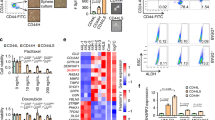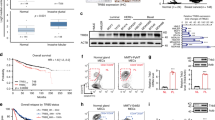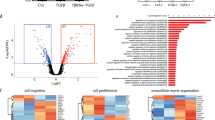Abstract
TRIM58 is a member of the TRIM protein family, which possess with E3 ubiquitin ligase activities. Studies have revealed that low expression of TRIM58 plays key roles, has been implicated in the tumor progression of tumor formation due to its reduced expression. However, its role in regulating the stemness of breast cancer stem cells (CSCs) remains unexplored. Here, we found that TRIM58 was underexpressed in TNBC tissues and cells compared to adjacent mucosa tissue, and its downregulation was significantly associated with shorter survival. Overexpression of TRIM58 reduced the proportion of CD44 + /CD24- cells, upregulated differentiation genes, and inhibited stemness-related gene expression in TNBC CSCs. In vitro and in vivo experiments revealed that TRIM58 overexpression in CSCs suppressed tumor sphere formation and tumorigenic capacity. Co-IP results indicated direct interaction between TRIM58 and MYH9, with TRIM58 inducing MYH9 degradation via ubiquitination in differentiated cells. Label-free quantitative proteomics identified GRK3 and Hippo-YAP as downstream targets and signaling pathways of MYH9. TIMER database analysis, immunohistochemistry, western blotting, DNA-protein pulldown experiments, and dual luciferase reporter assays demonstrated that MYH9 regulated GRK3 transcriptional activation in CSCs. In conclusion, elevated TRIM58 expression in CSCs downregulates MYH9 protein levels by promoting ubiquitin-mediated degradation, thereby inhibiting downstream GRK3 transcription, inactivating the YAP stemness pathway, and ultimately promoting CSC differentiation.

This is a preview of subscription content, access via your institution
Access options
Subscribe to this journal
Receive 12 print issues and online access
$259.00 per year
only $21.58 per issue
Buy this article
- Purchase on Springer Link
- Instant access to full article PDF
Prices may be subject to local taxes which are calculated during checkout








Similar content being viewed by others
Data availability
The representative data are included in this article. The datasets used and/or analysed during the current study are available from the corresponding author (yangfan@ucas.ac.cn) upon reasonable request.
References
Kashyap D, Pal D, Sharma R, Garg VK, Goel N, Koundal D, et al. Global increase in breast cancer incidence: risk factors and preventive measures. BioMed Res Int. 2022;2022:9605439.
Tsang JYS, Tse GM. Molecular classification of breast cancer. Adv Anatom Pathol. 2020;27:27–35.
Derakhshan F, Reis-Filho JS. Pathogenesis of triple-negative breast cancer. Ann Rev Pathol. 2022;17:181–204.
Yin L, Duan JJ, Bian XW, Yu SC. Triple-negative breast cancer molecular subtyping and treatment progress. Breast Cancer Res. 2020;22:61.
Butti R, Gunasekaran VP, Kumar TVS, Banerjee P, Kundu GC. Breast cancer stem cells: biology and therapeutic implications. Int J Biochem Cell Biol. 2019;107:38–52.
Kuşoğlu A, Biray Avcı Ç. Cancer stem cells: A brief review of the current status. Gene. 2019;681:80–85.
Walcher L, Kistenmacher AK, Suo H, Kitte R, Dluczek S, Strauß A, et al. Cancer stem cells-origins and biomarkers: perspectives for targeted personalized therapies. Front Immunol. 2020;11:1280.
Clarke MF. Clinical and therapeutic implications of cancer stem cells. New England J Med. 2019;380:2237–45.
Biserova K, Jakovlevs A, Uljanovs R, Strumfa I. Cancer stem cells: significance in origin, pathogenesis and treatment of glioblastoma. Cells. 2021;10:621.
Clara JA, Monge C, Yang Y, Takebe N. Targeting signalling pathways and the immune microenvironment of cancer stem cells - a clinical update. Nat Rev Clin Oncol. 2020;17:204–32.
Zeng X, Liu C, Yao J, Wan H, Wan G, Li Y, et al. Breast cancer stem cells, heterogeneity, targeting therapies and therapeutic implications. Pharmacol Res. 2021;163:105320.
Nam NP, Fabio AS, Alex C, Ly NM, Deirdre C, Karlsson U, et al. Molecular biology of breast cancer stem cells: potential clinical applications. Cancer Treat Rev. 2020;36:485–91.
Yang F, Cui P, Lu Y, Zhang X. Requirement of the transcription factor YB-1 for maintaining the stemness of cancer stem cells and reverting differentiated cancer cells into cancer stem cells. Stem Cell Res Therapy. 2019;10:233.
Yang F, Chen S, He S, Huo Q, Hu Y, Xie N. YB-1 interplays with ERα to regulate the stemness and differentiation of ER-positive breast cancer stem cells. Theranostics. 2020;10:3816–32.
Hatakeyama S. TRIM family proteins: roles in autophagy, immunity, and carcinogenesis. Trends Biochem Sci. 2017;42:297–311.
Cai C, Tang YD, Zhai J, Zheng C. The RING finger protein family in health and disease. Signal Transduct Targeted Therapy. 2022;7:300.
Zhu Y, Afolabi LO, Wan X, Shim JS, Chen L. TRIM family proteins: roles in proteostasis and neurodegenerative diseases. Open Biol. 2022;12:220098.
Thom CS, Traxler EA, Khandros E, Nickas JM, Zhou OY, Lazarus JE, et al. Trim58 degrades Dynein and regulates terminal erythropoiesis. Dev Cell. 2014;30:688–700.
Liu X, Long Z, Cai H, Yu S, Wu J. TRIM58 suppresses the tumor growth in gastric cancer by inactivation of β-catenin signaling via ubiquitination. Cancer Biol Therapy. 2020;21:203–12.
Shi YX. Identification of the molecular function of tripartite motif containing 58 in human lung cancer. Oncology letters. 2021;22:685.
Yuan P, Zhou Y, Wang R, Chen S, Wang Q, Xu Z, et al. TRIM58 interacts with pyruvate kinase M2 to inhibit tumorigenicity in human osteosarcoma cells. BioMed Res Int. 2020;2020:8450606.
Shang R, Chen J, Gao Y, Chen J, Han G. TRIM58 Interacts with ZEB1 to Suppress NSCLC Tumor Malignancy by Promoting ZEB1 Protein Degradation via UPP. Disease markers. 2023;2023:5899662.
Liu JH, Yang HL, Deng ST, Hu Z, Chen WF, Yan WW, et al. The small molecule chemical compound cinobufotalin attenuates resistance to DDP by inducing ENKUR expression to suppress MYH9-mediated c-Myc deubiquitination in lung adenocarcinoma. Acta Pharmacol Sin. 2022;43:2687–95.
Ye G, Yang Q, Lei X, Zhu X, Li F, He J, et al. Nuclear MYH9-induced CTNNB1 transcription, targeted by staurosporin, promotes gastric cancer cell anoikis resistance and metastasis. Theranostics. 2020;10:7545–60.
Yu SY, Takahashi S, Arinami T, Ohkubo T, Nemoto Y, Tanabe E, et al. Mutation screening and association study of the beta-adrenergic receptor kinase 2 gene in schizophrenia families. Psychiatry Res. 2004;125:95–104.
Li Y, Fan Y, Xu J, Huo L, Scott AW, Jin J, et al. GRK3 is a poor prognosticator and serves as a therapeutic target in advanced gastric adenocarcinoma. J Exp Clin Cancer Res. 2022;41:257.
Yuan B, Liu J, Shi A, Cao J, Yu Y, Zhu Y, et al. HERC3 promotes YAP/TAZ stability and tumorigenesis independently of its ubiquitin ligase activity. EMBO J. 2023;42:e111549.
Wang J, Yang F, Zhuang J, Huo Q, Li J, Xie N. TRIM58 inactivates p53/p21 to promote chemoresistance via ubiquitination of DDX3 in breast cancer. Int J Biochem Cell Biol. 2022;143:106140.
Zheng YZ, Li JY, Ning LW, Xie N. Predictive and prognostic value of TRIM58 protein expression in patients with breast cancer receiving neoadjuvant chemotherapy. Breast Cancer (Dove Med Press). 2022;14:475–87.
Pecci A, Ma X, Savoia A, Adelstein RS. MYH9: Structure, functions and role of non-muscle myosin IIA in human disease. Gene. 2018;664:152–67.
Althaus K, Greinacher A. MYH9-related platelet disorders. Semin Thrombosis Hemostasis. 2009;35:189–203.
Bai C, Su M, Zhang Y, Lin Y, Sun Y, Song L, et al. Oviductal glycoprotein 1 promotes hypertension by inducing vascular remodeling through an interaction with MYH9. Circulation. 2022;146:1367–82.
Zhong Y, Long T, Gu CS, Tang JY, Gao LF, Zhu JX, et al. MYH9-dependent polarization of ATG9B promotes colorectal cancer metastasis by accelerating focal adhesion assembly. Cell Death Differentiation. 2021;28:3251–69.
Gao S, Wang S, Zhao Z, Zhang C, Liu Z, Ye P, et al. TUBB4A interacts with MYH9 to protect the nucleus during cell migration and promotes prostate cancer via GSK3β/β-catenin signalling. Nat Commun. 2022;13:2792.
Lin X, Li AM, Li YH, Luo RC, Zou YJ, Liu YY, et al. Silencing MYH9 blocks HBx-induced GSK3β ubiquitination and degradation to inhibit tumor stemness in hepatocellular carcinoma. Signal Transduct Targeted Therapy. 2020;5:13.
Kai JD, Cheng LH, Li BF, Kang K, Xiong F, Fu JC, et al. MYH9 is a novel cancer stem cell marker and prognostic indicator in esophageal cancer that promotes oncogenesis through the PI3K/AKT/mTOR axis. Cell Biol Int. 2022;46:2085–94.
Fang CL, Tian YF, Lin SS, Hung ST, Hseu YC, Chang CC, et al. GRK3 as a prognosis biomarker in gastric cancer. J Cancer. 2022;13:1299–306.
Alm M, Gracias J, Kegel ME, Zheng Y, Faka A, Svedberg M, et al. GRK3 deficiency elicits brain immune activation and psychosis. Mol Psychiatry. 2021;26:6820–32.
Liu WJ, Zhou L, Liang ZY, Zhou WX, You L, Zhang TP, et al. High expression of GRK3 is associated with favorable prognosis in pancreatic ductal adenocarcinoma. Pathol Res Pract. 2018;214:228–32.
Jin Y, Liang ZY, Zhou WX, Zhou L. Expression and significances of G-protein-coupled receptor kinase 3 in hepatocellular carcinoma. J Cancer. 2017;8:1972–8.
Woerner BM, Luo J, Brown KR, Jackson E, Dahiya SM, Mischel P, et al. Suppression of G-protein-coupled receptor kinase 3 expression is a feature of classical GBM that is required for maximal growth. Mol Cancer Res. 2012;10:156–66.
Billard MJ, Fitzhugh DJ, Parker JS, Brozowski JM, McGinnis MW, Timoshchenko RG, et al. G protein coupled receptor kinase 3 regulates breast cancer migration, invasion, and metastasis. PLoS ONE. 2018;11:e0152856.
Jiang T, Yang C, Ma L, Wu Z, Ye L, Ma X, et al. Overexpression of GRK3, promoting tumor proliferation, is predictive of poor prognosis in colon cancer. Disease Markers. 2017;2017:1202710.
Funding
This work was supported by the Zhejiang Provincial Natural Science Foundation of China under Grant No. LY22H160010; Medical Scientific Research Foundation of Zhejiang Province, Grant No. 2021KY338, 2023KY1086; Ningbo Natural Science Foundation, Project ID: 2021J318, 2021J311, 2023J325; Project of Ningbo Leading Medical & Health Discipline, Project No: 2022-B13.
Author information
Authors and Affiliations
Contributions
YF designed and analyzed the experiments. LXJ and JJ wrote the manuscript. LXJ and YF performed and analyzed the experiments and prepared the figures. LXJ, JJ, WQ, YTZ performed the experiments. YF guided the experiment. LXJ and JJ contributed equally to this work. All authors have read and approved the final manuscript.
Corresponding author
Ethics declarations
Ethical approval
Animal experiments were approved by the Animal Ethics Committee of Ningbo Institute of Life and Health Industry, Ningbo, Zhejiang, China (Approval number: GK-2023-XM-0076). All surgical procedures were performed under full anesthesia, and all efforts were made to minimize animal suffering. All the animals were handled according to the Ministry of Health guidelines for the care and use of laboratory animals (GB 14925–2001). The human study was approved by the Committee on Ethics of Ningbo No.2 Hospital, Ningbo, Zhejiang, China (Approval number: PJ-NBEY-KY-2020-191-01). The experiments were undertaken with the understanding and written consent of each subject. The study methodologies conformed to the standards set by the Declaration of Helsinki.
Competing interests
The authors declare no competing interests.
Additional information
Publisher’s note Springer Nature remains neutral with regard to jurisdictional claims in published maps and institutional affiliations.
Supplementary information
Rights and permissions
Springer Nature or its licensor (e.g. a society or other partner) holds exclusive rights to this article under a publishing agreement with the author(s) or other rightsholder(s); author self-archiving of the accepted manuscript version of this article is solely governed by the terms of such publishing agreement and applicable law.
About this article
Cite this article
Li, X., Jiang, J., Wu, Q. et al. TRIM58 downregulation maintains stemness via MYH9-GRK3-YAP axis activation in triple-negative breast cancer stem cells. Cancer Gene Ther (2024). https://doi.org/10.1038/s41417-024-00780-w
Received:
Revised:
Accepted:
Published:
DOI: https://doi.org/10.1038/s41417-024-00780-w



